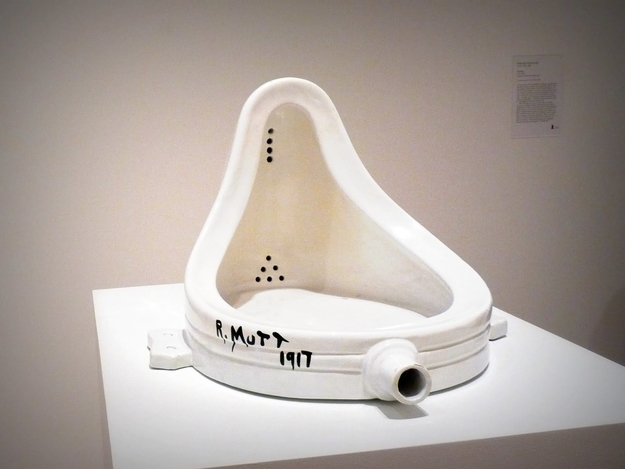Marcel Duchamp forced a new form of imagery in his controversial 1917 piece named Fountain, a porcelain urinal positioned 90 degrees from its original upright stance, marking the obscured, artistic beginning of “readymade” art.
Fountain has been said to be the result of a series of events in Duchamp’s life in New York City, possibly in collaboration with an assistant that has never been positively identified. The signature “R. Mutt 1917”, written on the side of the urinal, also attract people’s curiosity. Some say it derives from the name of the urinal’s original manufacturer, J.L. Mott Iron Works. Other theories suggest the name comes from a contemporary cartoon strip. No matter the origin of the piece, its mysterious nature continues to conjure up considerations and skepticism of further meaning behind the name.
But is it art? The Society of Independent Artists in New York City, of which Marcel Duchamp was a board member, did not think so. Unaware of it being Duchamp’s work, they refused to exhibit Fountain in an open exhibition hosted by the organization itself, a decision that made quite the stir. Little did they know that Duchamp’s urinal would be an enduring inspiration for 20th and 21st century artists, conveying more profound and artistic content and connotations of already existing objects, replacing, enhancing or altering their original purpose. Fountain marks a seminal point in art invention. After The Society of Independent Artists’ rejection of the piece, the original Fountain was lost. However, 17 original replicas created by Duchamp and commissioned by various art institutions exist and are found in exhibitions all over the world.
In fact, Duchamp’s piece has become one of the most replicated art works from the 20th century. Many different artists have interpreted it in their own way creating a plethora of urinal-based designs. The urinal’s physical resemblance is said to look like that of a woman’s body, which has sparked many erotic interpretations of the piece. One could argue that the curvature, reflective of a woman’s body, is a contradiction of the original, masculine use. Others have said, “it is a masculine property, but clearly one which has the feminine properties of receiving a man’s fluids” (Rob Sharp). Miguel Andrés, a modern performance artist has taken the inspiration from Duchamp’s piece to the next level by using his body as a human "fountain". The artist simply undresses, writes “R. Mutt 2013” on his stomach, and tapes up his manhood so it appears erect. He then proceeds to urinate, thus imitating the purpose and appearance of a fountain. Andrés creates a contemporary and candidly bold interpretation of an already dubious art work. This presentation demands attention from his audience and, once observed, causes involuntary visual absorption. Whether or not you are convinced that this is artistic brilliance, many people are eventually persuaded by the inventive, raw nature of unforeseen art work which in turn creates a turning point into a new art generation. This is maybe what Duchamp means when he states that “you can make people swallow anything, that’s what happened with Fountain.”
